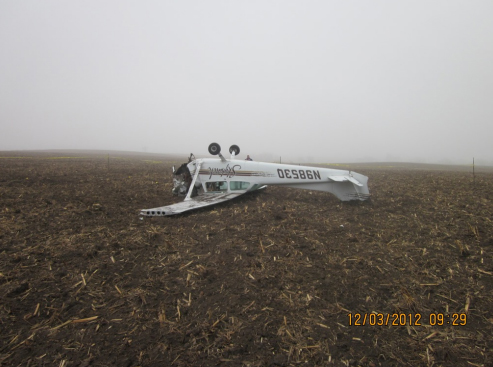It took nearly four years, but the National Transportation Safety Board has now closed its investigation into how four people on the way home from a Packers-Vikings game ended up upside down in an airplane in Rochester.
Scott Lebovitz, 23, of Owatonna, and three passengers Daniel Cronk, 36; Alan De Keyrel, 38; and a 9-year-old boy, all from Byron — suffered only bumps and bruises in the December 2012 crash.
The NTSB’s conclusion wasn’t much of a surprise (see NewsCut: “How Planes Crash” – 12/12/12) as one of the passengers had already published a first-person account of the accident in which he says he never saw the runway as the plane descended through fog.
We were 30-40 miles from Rochester when discussions about the weather became more serious. Planes were being diverted due to heavy fog. The air traffic controller suggested Dodge Center or Waseca as a “clear” option. After a brief discussion, we decided that Dodge Center would be a smart choice.
Our pilot, Scott, called up weather information for Dodge Center only to discover conditions had worsened. It was no longer an option to land in Dodge Center. Rochester Tower chimed in again and asked us what we wanted to do. ATC suggested Austin while we pondered our options. We joked about heading to Owatonna and hitting up happy hour at Applebees while we waited for our wives to come pick us up. Ultimately, the smart choice was Austin.
Just as we turned, a Citation flying a few thousand feet below us decided to attempt landing in Rochester. I watched out the window as the Citation disappeared into the clouds toward the barely visible flashing runway approach lights. ATC then reported that they had successfully landed and asked us what we wanted to do. In the blink of an eye, Scott decided to attempt the landing. We turned towards Runway 13.
In its final report, the NTSB said the pilot likely became disoriented in the clouds and darkness and had difficulty following his flight instruments:
The weather and light conditions at the time of the accident and the pilot’s maneuvering during the approach were conducive to the development of spatial disorientation. Therefore, it is likely that the pilot became spatially disoriented during the instrument approach, which resulted in the airplane descending below decision height and impacting terrain outside the lateral limits of the localizer. The pilot’s lack of recent instrument flight experience likely contributed to him becoming spatially disoriented during the instrument approach.
The four were lucky. In similar situations, few people ever walk away from the wreckage.

